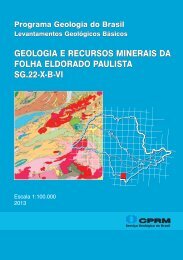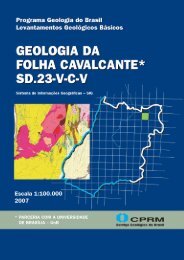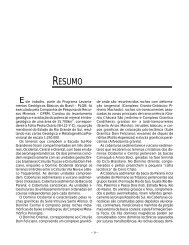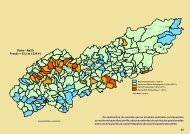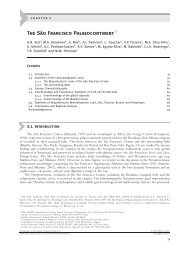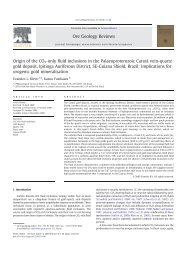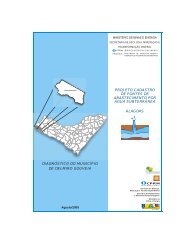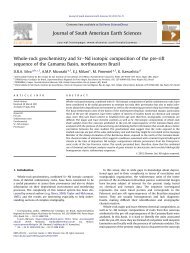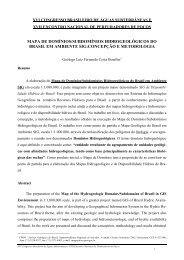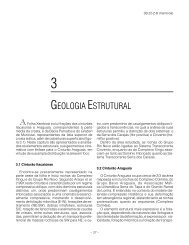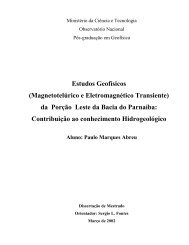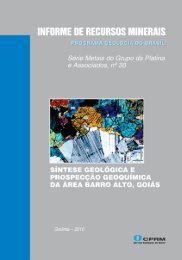Mercury and Methylmercury in Long Island Sound - CPRM
Mercury and Methylmercury in Long Island Sound - CPRM
Mercury and Methylmercury in Long Island Sound - CPRM
Create successful ePaper yourself
Turn your PDF publications into a flip-book with our unique Google optimized e-Paper software.
MERCURY CYCLING IN AND EMISSIONS FROM LONG ISLAND SOUND<br />
Prentiss H. Balcom 1, 4 , Carl H. Lamborg 1 , William F. Fitzgerald 1 , Grace M. V<strong>and</strong>al 2 ,<br />
Kristofer R. Rolfhus 3 , Connie S. Langer 2 <strong>and</strong> Chun-Mao Tseng 1<br />
1<br />
Department of Mar<strong>in</strong>e Sciences, University of Connecticut, Groton, CT 06340; 2 Pfizer Pharmaceutical,<br />
Inc., Groton, CT 06340; 3 Water Chemistry Program, University of Wiscons<strong>in</strong>-Madison, Madison,<br />
WI 53706 ; 4 FAX- 860-405-9153, prentiss.balcom@uconn.edu<br />
ABSTRACT<br />
Elemental mercury (Hg 0 ) emissions from <strong>Long</strong> Isl<strong>and</strong> <strong>Sound</strong> (LIS; 85-90 kg yr -1 ) are pr<strong>in</strong>cipally<br />
of anthropogenic orig<strong>in</strong> (>70%), <strong>and</strong> evasional Hg loses (35% of total LIS <strong>in</strong>puts) are a significant<br />
source of Hg to the coastal/regional atmosphere (e.g. CT, NY, NJ). LIS waters are generally supersaturated<br />
with Hg 0 (72-1154%), <strong>and</strong> concentrations <strong>in</strong> surface waters (61-816 fM) vary both spatially<br />
<strong>and</strong> seasonally. Biotically mediated <strong>and</strong> photochemical reduction of reactant Hg (i.e., labile species) <strong>in</strong><br />
seawater are the pr<strong>in</strong>cipal mechanisms for the <strong>in</strong> situ production of elemental Hg. This production<br />
reduces the availability of labile species for the biologically mediated production of toxic methylmercury<br />
(MMHg) <strong>in</strong> coastal waters. The control that Hg 0 cycl<strong>in</strong>g exerts on MMHg bioaccumulation is also<br />
illustrated by the mass balance. External sources (~4 kg y -1 ) <strong>and</strong> <strong>in</strong> situ production (5-10 kg y -1 ) of<br />
MMHg <strong>in</strong> LIS account for only about 5% of the total <strong>in</strong>puts <strong>and</strong> 10-15% of the evasional mass flux.<br />
These results provide valuable data to aid <strong>in</strong> underst<strong>and</strong><strong>in</strong>g the biogeochemical cycl<strong>in</strong>g of Hg <strong>and</strong><br />
MMHg <strong>in</strong> nearshore regions <strong>and</strong> assess<strong>in</strong>g impact from pollutant Hg <strong>in</strong>puts.<br />
INTRODUCTION<br />
We are currently conduct<strong>in</strong>g a long-term study of Hg <strong>in</strong> our local waters, <strong>Long</strong> Isl<strong>and</strong> <strong>Sound</strong><br />
(LIS). Environmental Hg studies have typically focused on terrestrial regions, especially aquatic ecosystems.<br />
In contrast, estuaries <strong>and</strong> adjacent coastal waters, which are major repositories for natural <strong>and</strong><br />
pollutant riverborne/watershed derived Hg species, have received scant attention. There is a vital need<br />
to <strong>in</strong>crease knowledge <strong>and</strong> underst<strong>and</strong><strong>in</strong>g concern<strong>in</strong>g the biogeochemical cycl<strong>in</strong>g of Hg, <strong>and</strong> the impact<br />
of anthropogenically related <strong>in</strong>puts, <strong>in</strong> biologically productive nearshore regions. <strong>Methylmercury</strong> is of<br />
particular concern because it is considerably more toxic to organisms than other forms of Hg, <strong>and</strong> the<br />
primary exposure of humans to MMHg is by consumption of mar<strong>in</strong>e fish <strong>and</strong> fish products.<br />
<strong>Long</strong> Isl<strong>and</strong> <strong>Sound</strong> is a large urbanized coastal embayment, <strong>and</strong> among the world’s most<br />
important commercial <strong>and</strong> recreational coastal resources. The atmospheric <strong>and</strong> aquatic biogeochemical<br />
Hg cycle associated with LIS <strong>and</strong> its environs is affected not only by localized discharges (e.g., rivers,<br />
waste water treatment facilities) <strong>and</strong> tidal exchange, but from the direct <strong>and</strong> <strong>in</strong>direct (via watershed<br />
leach<strong>in</strong>g) airborne transport <strong>and</strong> deposition of Hg from regional <strong>and</strong> longer range sources. Inputs of<br />
significance to LIS are: the East River (western region) with its large sewage load<strong>in</strong>gs, <strong>and</strong> the Connecticut<br />
River (eastern zone) which contributes about 70% of annual <strong>in</strong>put of freshwater, <strong>and</strong> whose extensive<br />
watershed <strong>and</strong> potential for leach<strong>in</strong>g of atmospherically derived Hg extends northward <strong>in</strong>to Canada.<br />
The <strong>Sound</strong> provides an ideal coastal laboratory <strong>in</strong> which to exam<strong>in</strong>e important mercury species such as<br />
Hg 0 <strong>and</strong> MMHg with<strong>in</strong> the multi-media framework of a broader exam<strong>in</strong>ation <strong>in</strong>to natural <strong>and</strong> humanrelated<br />
sources, the processes <strong>and</strong> reactions controll<strong>in</strong>g the aquatic biogeochemistry of Hg, <strong>and</strong> its<br />
amplification as the MMHg species <strong>in</strong> biota.
METHODS<br />
Elemental Hg measurements were made dur<strong>in</strong>g a series of 3-4 day cruises on LIS with an<br />
automated gaseous elemental mercury analyzer (AGEMS) developed by our laboratory, <strong>and</strong> us<strong>in</strong>g<br />
traditional methods <strong>in</strong> the laboratory (Rolfhus & Fitzgerald, <strong>in</strong> review). Earlier Hg 0 measurements, as<br />
well as measurement of other Hg species, were made between 1995 <strong>and</strong> 1997. Atmospheric Hg <strong>in</strong>puts<br />
to LIS were assessed by total Hg determ<strong>in</strong>ations <strong>in</strong> bulk deposition samplers sited at 4 locations on the<br />
north shore of the <strong>Sound</strong> over an 18 month period. Total, reactive <strong>and</strong> MMHg concentrations were<br />
determ<strong>in</strong>ed <strong>in</strong> samples from 4 target rivers, at sites above the salt <strong>in</strong>trusion. The Connecticut River was<br />
more extensively sampled over 14 months dur<strong>in</strong>g representative flow regimes. Additionally, Hg species<br />
determ<strong>in</strong>ations were made <strong>in</strong> effluent from 7 water treatment facilities <strong>in</strong> Connecticut, as well as at<br />
multiple locations <strong>in</strong> the waters of LIS over a period of 26 months (V<strong>and</strong>al et al., <strong>in</strong> prep.).<br />
RESULTS AND DISCUSSION<br />
Our research has yielded useful first-order biogeochemical mass balances (i.e., sources <strong>and</strong><br />
s<strong>in</strong>ks) for total <strong>and</strong> MMHg <strong>in</strong> LIS. The estimated current annual Hg load<strong>in</strong>gs to LIS are approximately<br />
230 kg, of which about 75% (180 kg) is of pollutant orig<strong>in</strong>. The pr<strong>in</strong>cipal sources of Hg to the <strong>Sound</strong><br />
are wastewater treatment facilities, (WTFs, ~85 kg y -1 ; 38%), rivers (~120 kg y -1 ; 52%), <strong>and</strong> direct<br />
atmospheric deposition (~26 kg y -1 ; 10%) (V<strong>and</strong>al et al., <strong>in</strong> prep.; Fitzgerald et al., <strong>in</strong> press) (Figure 1).<br />
More than 85% of WTF flux (i.e., ~74 kg y -1 ) is estimated to be from NY sewage facilities discharg<strong>in</strong>g<br />
<strong>in</strong>to the East River <strong>and</strong> consequently <strong>in</strong>to the western <strong>Sound</strong>. River<strong>in</strong>e fluxes at ~120 kg y -1 are the<br />
major Hg source to LIS. The Connecticut River contributes about 70% of this <strong>in</strong>put (~84 kg y -1 ).<br />
Direct wet atmospheric Hg deposition is a relatively small <strong>in</strong>put to the <strong>Sound</strong>. However, deposition of<br />
Hg to the watershed <strong>and</strong> subsequent leach<strong>in</strong>g is an important contributor to the Hg load<strong>in</strong>gs via rivers.<br />
We suggest that the estimated Hg flux from the Connecticut River could be due entirely to its watershed<br />
if 25% of the atmospheric Hg load<strong>in</strong>gs runs off.<br />
Although the mass balance needs constra<strong>in</strong>ts, the pr<strong>in</strong>cipal external sources (~4 kg y -1 ) of<br />
MMHg to the <strong>Sound</strong> are WTFs (~1.4 kg y -1 ; 35%), rivers (~1.6 kg y -1 ; 40%), <strong>and</strong> direct atmospheric<br />
deposition at about ~0.7 kg y -1 (18%)(V<strong>and</strong>al et al., <strong>in</strong> prep.; Figure 2). Our marsh <strong>and</strong> near shore<br />
studies suggest that the major source of MMHg <strong>in</strong> LIS is <strong>in</strong>ternal production. Studies of net Hg methylation<br />
<strong>in</strong> two Connecticut salt marshes po<strong>in</strong>t to nearshore sedimentary regimes as regions of significant<br />
production (Langer et al., <strong>in</strong> press). We hypothesize that as much as 6 to 18 kg y -1 of MMHg are<br />
formed through the microbial conversion of reactive mercury (Hg ) species <strong>in</strong>to MMHg <strong>in</strong> shallow<br />
R<br />
sedimentary regions of LIS. Net <strong>in</strong> situ microbially mediated MMHg production may be two to five<br />
times greater than the fluxes from rivers, sewage, <strong>and</strong> the atmosphere. The pr<strong>in</strong>cipal source of this toxic<br />
species <strong>in</strong> mar<strong>in</strong>e aquatic systems is <strong>in</strong> situ biologically-mediated conversion of Hg . Sulfate reduc<strong>in</strong>g<br />
R<br />
bacteria (SRB) have been implicated as the primary synthesizers. The aqueous production of Hg 0<br />
competes for reactant (i.e., ionic Hg or Hg ) with the <strong>in</strong> situ biological synthesis of MMHg, such that<br />
R<br />
water bodies with a large production of Hg 0 may have smaller amounts of MMHg <strong>in</strong> biota <strong>and</strong> accumulation<br />
<strong>in</strong> the sediment.<br />
Elemental Hg is nearly always found to be supersaturated (72-1154%) <strong>in</strong> LIS (Figure 3),<br />
<strong>in</strong>dicat<strong>in</strong>g reduction of ionic Hg (reactant). General trends <strong>in</strong>clude higher supersaturation dur<strong>in</strong>g warmer<br />
months <strong>and</strong> <strong>in</strong> the middle of the <strong>Sound</strong> near the mouth of the Connecticut River (Rolfhus & Fitzgerald, <strong>in</strong><br />
review). Supersaturation of Hg 0 suggests Hg is lost from the <strong>Sound</strong> to the atmosphere via evasion.<br />
Wann<strong>in</strong>khof (1992) is currently our gas exchange “model of choice” based on its wide acceptance <strong>and</strong><br />
successful application to other gases. Evasional flux estimates (122-822 pmol m -2 d -1 ) for each of the
Hg 0 surveys <strong>in</strong> LIS waters are summarized <strong>in</strong> Figure 4. General trends <strong>in</strong>clude <strong>in</strong>creased Hg 0 flux at<br />
<strong>in</strong>creased Hg 0 concentrations dur<strong>in</strong>g warmer months <strong>and</strong> <strong>in</strong> the central <strong>Sound</strong>, as well as at higher w<strong>in</strong>d<br />
velocities. Averaged over the year for LIS, the calculated reduction rate required to ma<strong>in</strong>ta<strong>in</strong> steady<br />
state (ave. total Hg is 6pM) <strong>and</strong> to balance evasion is 0.4% per day (Rolfhus, 1998). Laboratory<br />
measured reduction rates of 0.5 to 3% d -1 for both biotic <strong>and</strong> abiotic reduction processes are more than<br />
sufficient to susta<strong>in</strong> the estimates for evasional fluxes of Hg 0 from LIS.<br />
One of the most strik<strong>in</strong>g f<strong>in</strong>d<strong>in</strong>gs from our work is the presence of significantly large emissions of<br />
Hg 0 from the waters of LIS to the local/regional atmosphere. While the importance of Hg 0 cycl<strong>in</strong>g <strong>in</strong><br />
natural waters is well known, its significance <strong>in</strong> coastal waters is just be<strong>in</strong>g revealed. The estimates for<br />
seasonal Hg 0 fluxes average 363 pmol m -2 d -1 which correspond to an annual Hg 0 emission from LIS of<br />
approximately 85-90 kg. The scale <strong>and</strong> importance of water to air Hg 0 volatilization is evident. For<br />
example, Hg 0 emissions from LIS surface waters are considerably larger than direct wet atmospheric<br />
Hg deposition as estimated from our four coastal atmospheric sampl<strong>in</strong>g stations (Figure 1). This production/emission<br />
cycle is remobiliz<strong>in</strong>g amounts of Hg comparable to the river <strong>in</strong>put or our values for<br />
annual Hg fluxes from the wastewater treatment facilities (WTFs). Indeed, as much as 35% of the Hg<br />
<strong>in</strong>put to LIS is transformed (reduced biotically <strong>and</strong> abiotically) <strong>and</strong> re-emitted to the atmosphere. S<strong>in</strong>ce<br />
most Hg enter<strong>in</strong>g LIS has an anthropogenic orig<strong>in</strong>, a substantial pollution component is be<strong>in</strong>g recycled.<br />
These f<strong>in</strong>d<strong>in</strong>gs from our LIS <strong>in</strong>vestigations <strong>in</strong>dicate that source/receptor models for atmospheric<br />
Hg cycl<strong>in</strong>g, especially when applied to coastal states, must consider Hg 0 emissions from coastal<br />
embayments <strong>and</strong> the cont<strong>in</strong>ental shelf. For example, if the emissions of Hg 0 <strong>in</strong> other coastal sett<strong>in</strong>gs<br />
were comparable to LIS (27 g km -2 y -1 ), then the efflux from shelf regions of the eastern U.S. (assum<strong>in</strong>g<br />
a coast length of 2400 km, <strong>and</strong> shelf width of 200 km) might approach 13 Mg y -1 (13 tons). This<br />
potential mobilization of Hg is extraord<strong>in</strong>arily large, <strong>and</strong> environmentally significant. Globally, the<br />
shallow coastal marg<strong>in</strong>s of the oceans total about 36 x 10 6 km 2 . As an upper limit, these mar<strong>in</strong>e<br />
regions could yield an annual water-air flux of Hg of about 1000 tons (5 Mmole), if Hg cycled <strong>in</strong> a<br />
manner similar to LIS.<br />
REFERENCES<br />
Fitzgerald WF, V<strong>and</strong>al GM, Rolfhus KR, Lamborg CH <strong>and</strong> Langer CS (<strong>in</strong> press), J. Environ. Sci..<br />
Langer CS, Fitzgerald WF <strong>and</strong> V<strong>and</strong>al GM (<strong>in</strong> press), Wetl<strong>and</strong>s Ecology <strong>and</strong> Management.<br />
Rolfhus KR (1998), PhD Dissertation, The University of Connecticut.<br />
Rolfhus KR & Fitzgerald WF (<strong>in</strong> review), Geochim. Cosmochim. Acta..<br />
V<strong>and</strong>al GM, Rolfhus KR, Lamborg CH, Langer CS <strong>and</strong> Fitzgerald WF (<strong>in</strong> prep.), Report to CT D.E.P.<br />
Wann<strong>in</strong>khof R (1992), JGR97/C5: 7373-7382.
Direct Atmos. Dep.<br />
+26±7 (100% reactive)<br />
W.T.F.'s<br />
+90±20 (30% reactive)<br />
Rivers<br />
+120±30 (50% reactive)<br />
(90±20 from watershed)<br />
Tidal Exchange Burial*<br />
Volatilization<br />
-90±30<br />
-24 -122±70<br />
Figure 1. Total Hg Budget for LIS (kg/y)<br />
*by difference<br />
Atmos. Dep.<br />
Figure 4. Elemental Hg Fluxes from LIS



